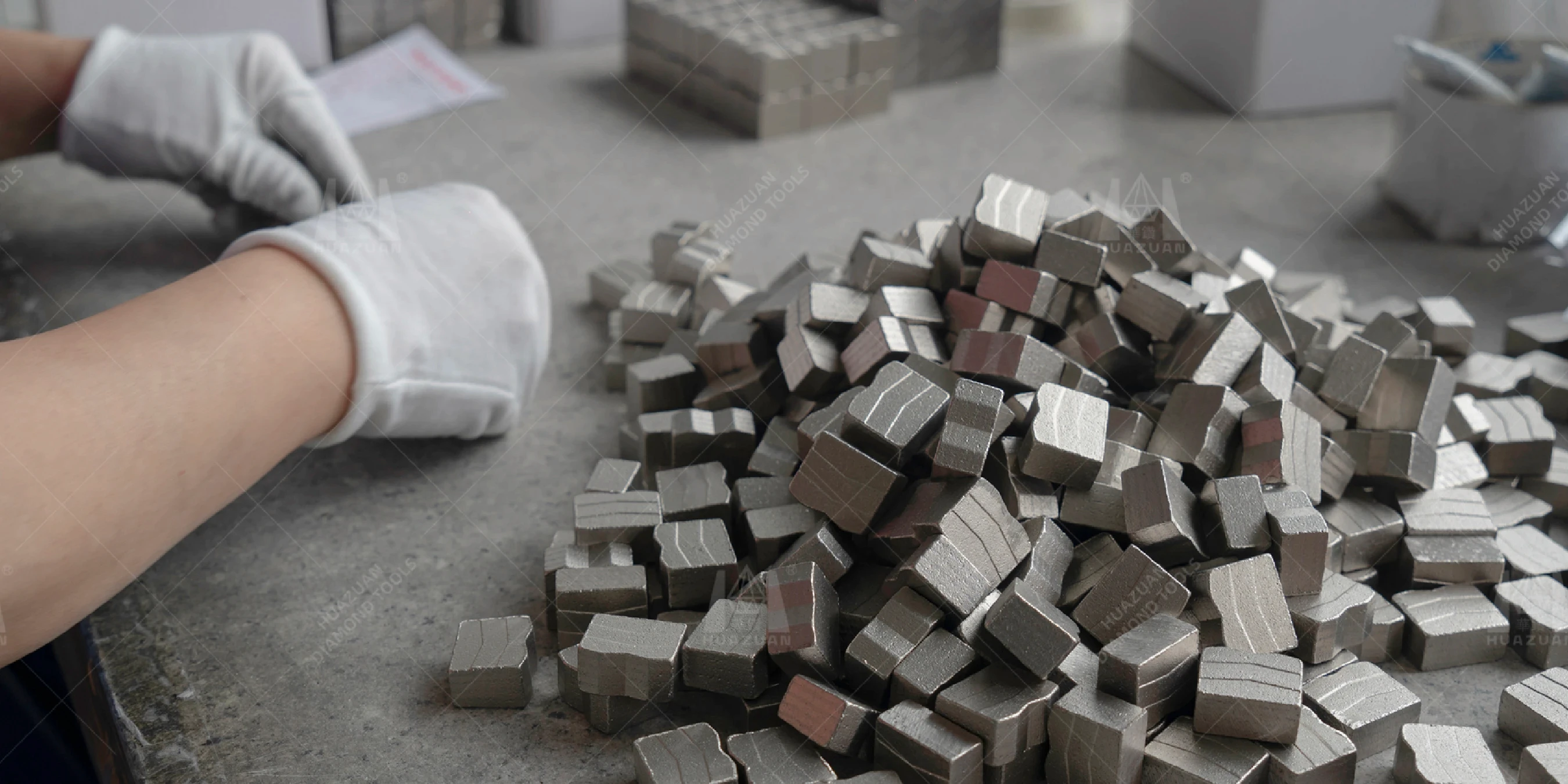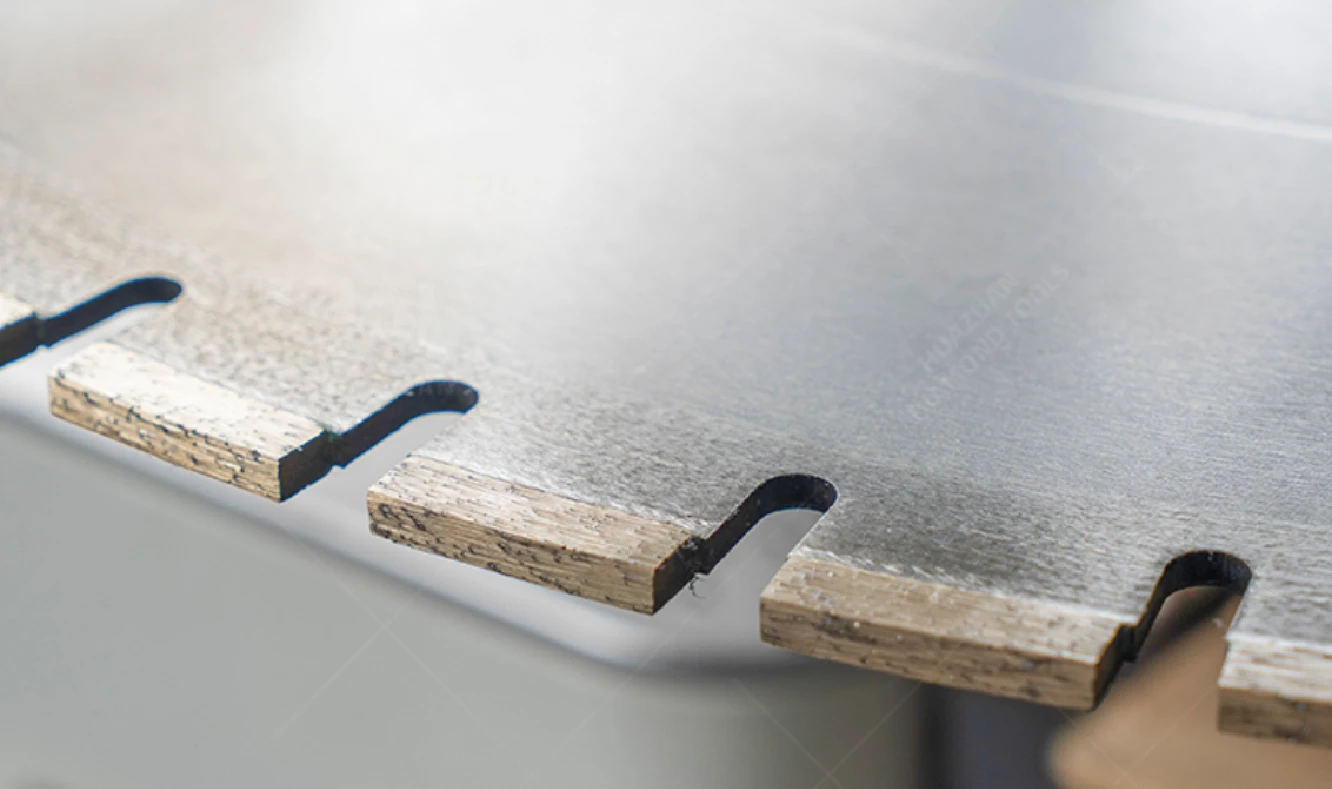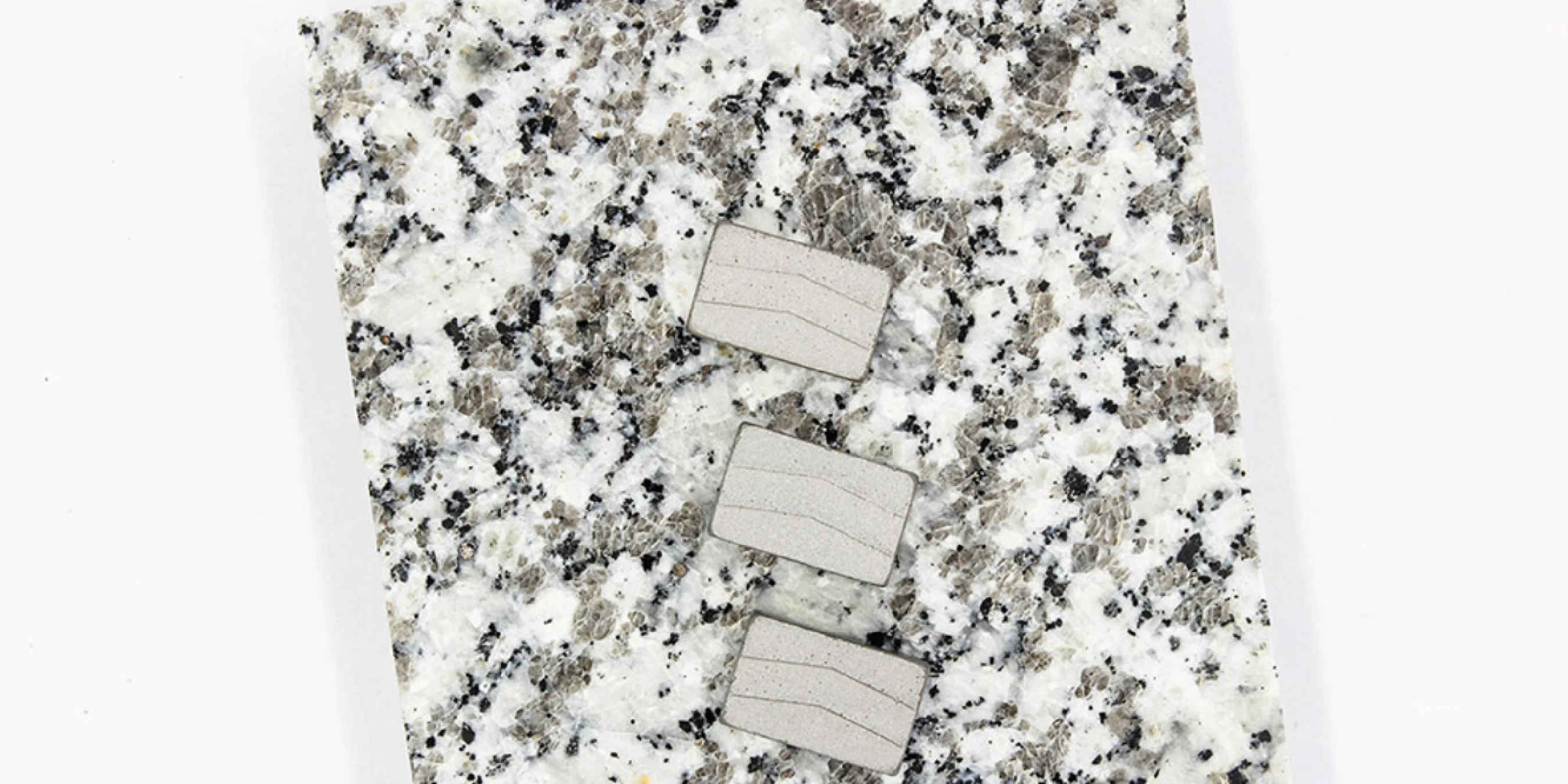Hi, this is Lizzy from Dinosaw ( Not a Robot ). Which Machine ( model ) do you want? Please WhatsApp us now
Discover why wrong diamond segments cause 50% speed loss and 70% shorter blade life. Learn the critical bond-to-stone matching rule: hard stones need soft bonds, soft stones need hard bonds. Includes 4-step selection guide and expert troubleshooting tips.
Diamond segments control your blade's lifespan and cutting speed through bond erosion. Wrong bond causes two costly problems: glazing (50% speed loss) or early diamond loss (70% shorter life).
Solution: hard stones need soft bonds, soft stones need hard bonds.Granite's abrasiveness wears down soft bonds, exposing fresh diamonds. Marble can't wear down hard bonds, so you need durable matrix. This bond-hardness matching determines whether your blade cuts efficiently or fails prematurely.
Three key specs affect performance: diamond concentration (speed vs. life), mesh size (finish quality), welding technology (safety). Having blade problems or unsure about specs? Get expert guidance from our team to avoid costly mistakes.
The Core Principle: Matching Segment Bond to Stone Hardness
The most crucial concept in diamond segment technology is the dynamic relationship between the segment's metal bond and the hardness of the material being cut. The metal bond (or matrix) is a complex alloy, typically containing metals like cobalt, copper, iron, and tungsten. Its primary job is to hold the diamond crystals securely. But it also must erode at a controlled rate.
This erosion is what exposes the next layer of sharp diamonds. This process allows the blade to maintain its cutting ability. At Dinosaw, our 20+ years of experience have shown that a failure to match the bond to the application is the number one cause of poor blade performance.
An incorrect match leads to two primary problems. First, blade "glazing," where the diamonds are worn down without new ones being exposed. Second, premature segment wear, where diamonds are lost before their cutting life is fully utilized.
Why Hard Stone (Granite) Needs a Soft Bond Segment
It seems counterintuitive, but cutting hard, abrasive materials like granite requires a segment with a relatively softer metal bond. The reason lies in the physics of abrasion. Hard stones like granite are highly abrasive.
As the blade cuts, the stone actively grinds away at the metal bond matrix. A softer bond erodes more easily under this intense abrasion. This is precisely what's needed. This controlled erosion ensures that as the cutting edges of the exposed diamonds become dull, the matrix around them wears away just enough.
The worn diamond releases and exposes the fresh, sharp diamond crystal directly behind it. According to the Natural Stone Institute's technical resources , proper tool selection is paramount for both safety and efficiency. This constant renewal of the cutting surface allows the blade to maintain a high cutting speed and avoid glazing over.
Key takeaway for hard stone:
- Material: Granite, Quartzite, Hard Concrete.
- Required Bond: Soft to Medium-Soft.
- Mechanism: High abrasion from the stone wears down the bond, ensuring constant exposure of new, sharp diamonds.
- Result of Mismatch (using a hard bond): The bond won't wear away fast enough. The exposed diamonds will become dull and rounded, causing the blade to stop cutting (glazing) and potentially overheat.
Why Soft Stone (Marble) Needs a Hard Bond Segment
Conversely, when cutting softer, less abrasive materials like marble or limestone, a segment with a harder, more wear-resistant metal bond is required. Soft stones do not have the same abrasive effect on the bond matrix.
If a soft bond segment (designed for granite) were used on marble, the bond would offer little resistance to the cutting forces. The diamonds would be stripped away from the matrix long before they were dull. This leads to extremely rapid blade wear and a very short lifespan.
Therefore, a hard, durable bond is necessary to securely hold onto the diamond particles for as long as possible. This maximizes their cutting potential and extends the blade's life. This aligns with industry production data, where the longevity of abrasive products is a key performance indicator.
Key takeaway for soft stone:
- Material: Marble, Limestone, Travertine.
- Required Bond: Hard to Medium-Hard.
- Mechanism: The low abrasion of the stone requires a tough, wear-resistant bond to hold diamonds securely and prevent premature shedding.
- Result of Mismatch (using a soft bond): The bond wears away too quickly, diamonds are lost before their useful life is over, and the blade's lifespan is drastically reduced.
Key Technical Parameters You Must Know Before Buying
Beyond the fundamental principle of bond hardness, several other technical parameters directly influence a segment's performance. Understanding these allows you to make a much more informed purchasing decision. It's much like reading a spec sheet for a piece of machinery. When you evaluate our range of Diamond Tools , you'll find that we provide clear specifications to help you choose. Below is a table summarizing the crucial parameters and their impact on cutting operations.
| Parameter | Description | High Value (e.g., High Concentration) | Low Value (e.g., Low Concentration) | Best For... |
|---|---|---|---|---|
| Diamond Concentration | The amount of diamond carat per unit volume of the segment matrix. Measured on a scale where 100 concentration means the diamond volume is 25% of the total matrix volume. | Longer life, slower cutting speed. Suitable for abrasive materials. | Faster cutting speed, shorter life. Suitable for hard, non-abrasive materials. | High: Soft, abrasive stone. Low: Hard, dense stone. |
| Diamond Mesh Size (Grit) | The size of the individual diamond crystals. A lower number indicates a larger, coarser grit (e.g., 30/40 mesh), while a higher number indicates a smaller, finer grit (e.g., 60/80 mesh). | Aggressive, fast cutting with a rougher finish. High stock removal. | Slower, smoother cutting with a finer finish. Less chipping on brittle materials. | Coarse: Granite slab cutting. Fine: Ceramic, marble finishing cuts. |
| Segment Shape (Type) | The physical geometry of the segment. Common shapes include standard flat, M-type, K-type, and turbo. | Turbo/Grooved: Improved cooling and slurry removal, fast and aggressive cutting. | Standard/Flat: Smoother finish, longer life, good for general-purpose use. | Turbo: Materials requiring fast debris removal. Flat: Brittle materials needing a clean cut. |
| Welding Technology | The method used to attach the segments to the steel blade core. The two main types are high-frequency silver brazing and laser welding. | Laser Welding: Strongest bond, highest heat resistance, enhanced safety as segments are unlikely to detach. | Silver Brazing: Strong and reliable for most wet cutting applications, but has a lower heat tolerance than laser welding. | Laser: Demanding dry cutting, high-power saws. Brazing: Wet cutting, standard applications. |
A deep understanding of these parameters is essential. For instance, an academic paper on the effect of diamond concentration and matrix compositionconfirms that a lower concentration can, in some cases, improve cutting efficiency on hard granites. This happens by increasing the protrusion height of individual diamonds. This level of technical detail is what separates a high-performance blade from a standard one.
A 4-Step Checklist for Selecting the Right Diamond Segments
Translating technical knowledge into a practical purchasing decision can be challenging. Here is a straightforward, four-step checklist developed from our experience helping hundreds of stone fabricators optimize their cutting processes.
Step 1: Clearly Define Your Primary Cutting Material
First, identify the main material your blade will be cutting. Is it a single type of stone (e.g., exclusively Ubatuba granite) or a mix of materials? If you cut a variety, classify them by hardness and abrasiveness.For example, 70% hard stone (granite, quartzite) and 30% soft stone (marble). This analysis will be the foundation for your bond selection.
Step 2: Evaluate Your Cutting Equipment
The specifications of your saw are critical. Consider the following:
- Horsepower (HP or kW): High-power saws (>25 HP) can handle more aggressive segments with higher diamond concentration. Lower-power saws require "freer-cutting" segments (softer bonds, lower concentration) to avoid stalling the motor.
- RPM (Revolutions Per Minute): The blade's operating speed affects the force exerted on each diamond. Ensure the segment is designed for your machine's RPM range.
- Cutting Conditions: Will you be wet cutting or dry cutting? Wet cutting is always preferable as it cools the blade and segments, extending life and improving safety. If dry cutting is necessary, you must use laser-welded segments for safety.
Step 3: Define Your Performance Priority
Are you optimizing for cutting speed or blade longevity? While a perfect balance is ideal, often there is a trade-off.
- Speed Priority: If your bottleneck is the cutting process and you need maximum output, opt for a softer bond and coarser diamond grit. Be prepared for a shorter blade life.
- Lifespan Priority: If you are processing softer materials or your goal is to minimize tool replacement costs, choose a harder bond and potentially a higher diamond concentration. The cutting speed may be slightly lower.
- For a versatile solution, consider our Sintered Diamond Saw Blade for Ceramic , which is engineered for a balance of speed and fine finishing on delicate materials.
Step 4: Scrutinize the Supplier's Technical Data
Finally, request a detailed technical data sheet from your supplier. A reputable manufacturer like Dinosaw will provide clear information on bond type, diamond concentration, mesh size, and recommended applications.Be wary of suppliers who only compete on price and cannot provide technical specifications. The quality and transparency of this data are often direct indicators of the quality of the product itself. The VDMA, a German engineering association , sets high standards for machinery and tooling specifications. This reflects the importance of clear technical data in the industry.

Conclusion: Better Segments, Better Cutting
Choosing the right diamond segment is an engineering decision, not just a procurement task. By moving beyond a price-centric view and focusing on the technical interplay between the segment and the stone, you unlock significant gains in efficiency. You also reduce operational costs and improve the quality of your finished product.The core principles-matching bond hardness to stone abrasiveness and balancing diamond parameters for speed or life-provide a robust framework for making smarter choices.
At Dinosaw, we don't just sell blades; we provide cutting solutions built on a deep understanding of material science and practical application.We believe an educated customer is our best partner. Use this guide to re-evaluate your current tooling, ask your suppliers tougher questions, and start optimizing your operations from the cutting edge up.
Frequently Asked Questions (FAQs)
What is a diamond segment made of?
A diamond segment consists of industrial diamond crystals held in a powdered metal alloy matrix. The metal matrix (bond) is just as important as the diamonds.
The metal powder-typically a blend of cobalt, copper, iron, nickel, and tungsten-is mixed with a specific concentration of synthetic diamonds. This mixture is then pressed into shape and sintered at high temperature and pressure. This process fuses the metal powders into a solid block that holds the diamonds securely. Dinosaw utilizes advanced powder metallurgy to precisely control the bond's wear rate for different applications.
What does diamond "concentration" really mean in a segment?
Diamond concentration refers to the amount of diamond (in carats) per unit volume of the segment. The key point is that 100 concentration does not mean 100% diamond.
By industry standard, a 100 concentration means the diamond volume is 25% of the total segment matrix volume. A higher concentration (e.g., 120) increases the number of cutting points. This generally extends blade life but can reduce cutting speed. A lower concentration (e.g., 80) may cut faster in hard materials but will wear more quickly.
Can I use a single blade for both granite and marble?
You can, but it is highly inefficient and not recommended. The answer is no for professional results.
A blade designed for granite has a soft bond that will wear out extremely quickly on nonabrasive marble, wasting money. Conversely, a hard-bond marble blade will "glaze over" and stop cutting on granite. Using a "general purpose" blade means you are compromising performance on both materials. For optimal results, use a dedicated diamond segment for marble when cutting marble.
How do I know if my saw blade is "glazing"?
A glazed blade produces a high-pitched whining sound and the segment surface appears smooth and shiny. This happens when the metal bond is too hard for the material.
The bond fails to wear away to expose new, sharp diamonds. The exposed diamonds become dull and simply rub against the stone instead of cutting it. This generates excessive heat that can damage the segment and the blade core.
What is the difference between silver brazed and laser welded segments?
The difference lies in the strength and heat resistance of the bond joining the segment to the steel core. Laser welding is a safer, more durable technology.
Silver brazing uses a torch to melt a silver alloy (around 700°C) to join the parts. Laser welding uses a high-energy laser to fuse the metals directly. This creates a bond as strong as the materials themselves and with a much higher heat tolerance (above 1000°C). This is why laser-welded blades are the only type recommended for dry cutting. The extreme heat of dry cutting can cause brazed segments to detach.
What does the shape of the segment (e.g., M-Type, Turbo) affect?
The segment's shape primarily affects cooling, slurry removal, and initial cutting speed. Shape is engineered for specific performance traits.
A standard flat segment offers the smoothest cut and longest life. A "turbo" or grooved segment provides better water flow for cooling and helps eject cutting debris faster. This results in a more aggressive, faster cut. M-type or K-type segments have a unique geometry designed to reduce the initial contact area. This allows for a faster start to the cut with less pressure.
How much longer does a premium diamond blade last?
A premium blade can last anywhere from 2 to 10 times longer than a low-quality economy blade. The answer depends heavily on several factors.
These factors include the quality of diamonds, the sophistication of the bond technology, and the specific application. At Dinosaw, our premium segments are designed with high-grade synthetic diamonds and scientifically formulated bonds. These can deliver a 30-50% lower costper-meter-cut compared to standard blades, even if the initial purchase price is higher. The focus should be on total value, not just upfront cost.



























 English
English 中文
中文 Italian
Italian Türkçe
Türkçe Português
Português

